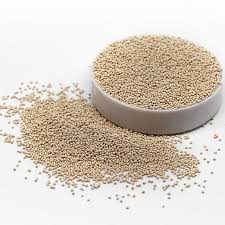News
Molecular sieve main application
Molecular sieve main application

Molecular sieve, as the name suggests that the material has a uniform microporous pore structure, smaller than the pore size of the molecule can be sucked into the pore, larger than the pore size of the molecule is blocked in the pore, according to the size of the molecule, the various components of the separation, currently people used to call this kind of material for zeolite or zeolite molecular sieve. The early study of zeolite molecular sieves originated in the 19th century and began to be industrialized in the 1960s. In recent years, the rapid development of zeolite molecular sieves in science and industry, but also promote its wide application in gas separation, catalysis, materials and other scientific fields. In this paper, the research status of zeolite molecular sieve and its application in air separation system are introduced in detail.
Zeolite molecular sieve has the structure and characteristics of crystal, the surface is a solid skeleton, the internal holes can play the role of adsorption molecules. The pores are connected with each other by channels through which molecules pass. Due to the crystalline nature of the pores, the pore size distribution of the molecular sieve is very uniform. Molecular sieve according to the size of the pore inside the crystal on the molecular selective adsorption, that is, the adsorption of a certain size of molecules and the exclusion of larger substances of the molecule, so it is called "molecular sieve" image.
The adsorption or repulsion functions of molecular sieves are affected by the electrical properties of the molecules. Synthetic zeolite has the special function of selective adsorption according to the size and polarity of the molecule, so it can be dried or purified on the gas or liquid, which is the basis of the molecular sieve can be separated. Synthetic zeolite can meet a wide range of industrial needs for adsorption and selection of characteristic products, in industrial separation is also widely used in the synthesis of zeolite molecular sieves.
The main application scope of molecular sieve:
Air separation
· Remove water and carbon dioxide from the air prior to liquefaction and cryogenic separation of nitrogen, oxygen, and other atmospheric gases
· Separate oxygen and nitrogen by pressure swing adsorption system or vacuum pressure swing adsorption system
· Desulphurization of high purity food-grade CO2
Oil refining
· Dehydration of refinery airflow, naphtha and diesel before alkylation feed and low temperature separation
· Remove water, HCl and H2S from materials in the reforming unit
· Remove the oxides in etherification residue and alkylation feed
· Remove HF and organic fluorine
· Removal of H2S to facilitate testing of copper strips transported through pipelines
· Remove nitrile from etherified feed
· Dehydration of ethanol
· Dehydrate and desulphurize the LPG fluid
· Separation of n-alkanes in branched and cyclic compounds
· Purification by PSA to improve the grading of hydrocarbon fluids
Remove Hg,
Petrochemical products
· Dehydration and purification of NGL/ ethane/propane feed
· Dehydration of pyrolysis gas, C2 and C3 tower feed, and hydrogen
· Low activity adsorbents for polymer fluids
· Dehydration and purification of ethylene, propylene and various other raw materials stored in the salt dome
· Remove water, carbon dioxide, methanol and other oxides, hydrogenated sulfur and sulfides, ammonia and mercury in ethylene, propylene, butene, pentene and various solvents and comonomers
· Removal of Hg, O2, CO2, H2S and/or COS
Natural gas
· Dehydration prior to cryogenic recovery of liquid natural gas and helium
· Dehydration of natural gas and natural gas condensate with high acid gas (CO2 and H2S) content
· Removal of sulfides from ethane, propane and butane
· Remove water and CO2 before methane liquefaction
· Remove water and sulfide to protect the gas pipeline
· Dehydration of liquid natural gas
· Desulphurize ammonia gas intake and other chemical equipment
· Remove mercury to prevent damage to aluminum heat exchangers
Refrigeration and air conditioning (A/C) systems
· Dehydrate the refrigeration systems and commercial refrigerants of automobile air conditioners, refrigerated vehicles, household refrigerators, refrigerating equipment, residential air conditioners, heat pumps, etc., to prevent freezing and corrosion
· Dehydration is carried out to prevent adverse chemical reactions of system materials
Air brake
· Dehydration of compressed air in brake systems of heavy and medium trucks, buses and trains
· The pressure swing adsorption dryer is used to reduce the dew point of the air in the liquid storage tank of the brake to below the ambient temperature to prevent freezing and corrosion
Air drier
· Dehydrate the plastic pellets before forming
· Dehydrate the instrument gas
· Dehydrate the indoor air with a desiccant wheel filled with adsorbent
Zeolite Products
Latest News
Contact Us
Contact: Ms.Anna Fei
Phone: +86-15036079565
Tel: +86-371-64368520
Email: info@meiqicn.com
Add:BEISHANKOU TOWN, GONGYI CITY, HENAN, CHINA 451200
